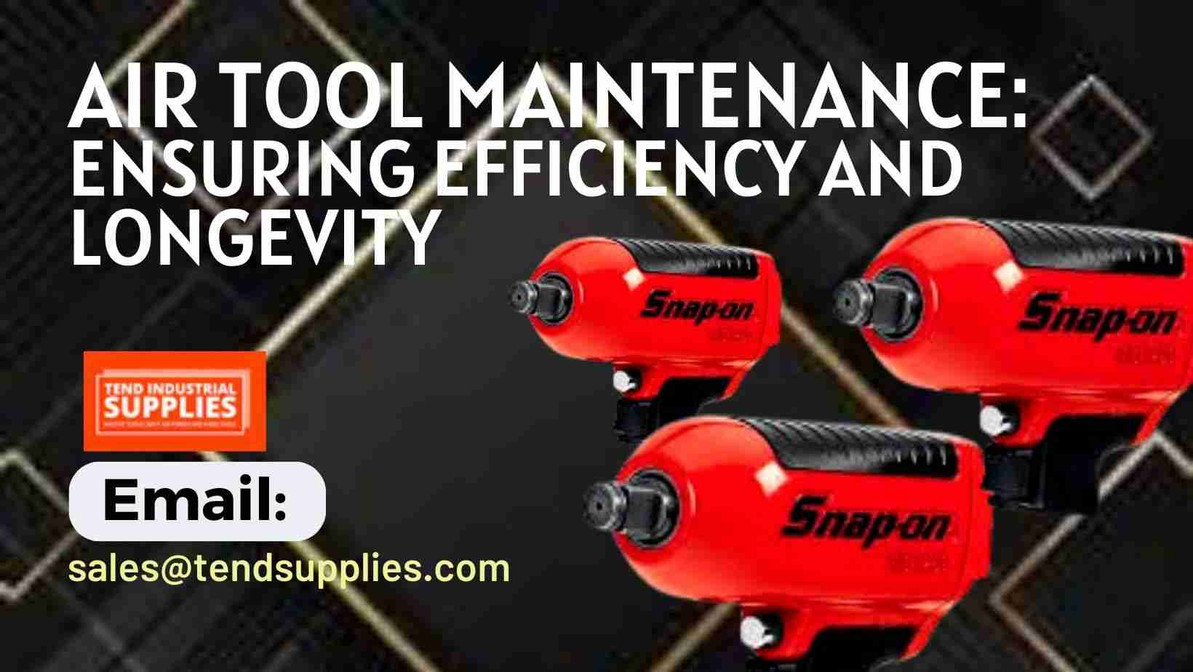Air Tool Maintenance: Ensuring Efficiency and Longevity
Introduction to Air Tool Maintenance
Air or pneumatic tools are vital components in various industrial, automotive, and construction activities. Their efficiency and speed make them indispensable, yet their performance heavily depends on regular maintenance. Understanding the importance of regular maintenance is vital to ensuring that these tools remain in top working condition, thereby extending their lifespan, maintaining efficiency, and reducing the risk of breakdowns.
Understanding Air Tools
Air tools operate on compressed air instead of electricity or battery power, making them lighter, more powerful, and often more durable than their counterparts. Common types of air tools include impact wrenches, air drills, pneumatic hammers, air sanders, and spray guns, each serving unique applications from vehicle repair to furniture making. Their operation involves converting the energy from compressed air into mechanical work, which is why keeping the air clean and dry is crucial for optimal performance.
General Maintenance Tips for Air Tools
Regular Cleaning and Lubrication: Dirt and debris can significantly hamper the performance of air tools. Regular cleaning after use prevents build-up that can lead to internal damage. Lubrication is equally important; a few drops of air tool oil in the air inlet before and after use keep the internal components running smoothly.
Proper Storage Practices: Store air tools in a clean, dry environment to prevent rust and corrosion. Disconnect them from the air supply and release all air pressure from the system before storage. Organizing tools properly ensures they are easily accessible and protected from accidental drops or impacts.
Routine Inspection for Wear and Tear: Regularly inspect air tools for signs of wear, such as cracked housings, damaged seals, or worn-out bearings. Early detection of these issues can prevent further damage and costly repairs.
Specific Maintenance Guides
Impact Wrenches: Check the anvil and hammer mechanism regularly for wear. Apply lubricant designed explicitly for impact wrenches to prevent lock-up and maintain torque levels.
Air Drills: Keep the chuck clean and lubricated. Check for loose or worn parts, and ensure the air is properly filtered to prevent internal damage from particulates.
Pneumatic Hammers: Inspect the piston and cylinder for signs of wear or damage. Use the correct type of oil to avoid gumming up the internal mechanisms, which can lead to decreased performance and increased wear.
Air Sanders: Clean the vent areas regularly to prevent dust build-up, which can affect the tool's speed and efficiency. Check the sanding pad for wear and ensure it's securely attached before each use.
Spray Guns: Clean thoroughly after each use, focusing on the nozzle and paint cup to prevent clogging and ensure an even spray pattern. Periodic disassembly for deep cleaning and replacement of seals or o-rings can significantly extend the life of the tool.
By adhering to these maintenance tips and guidelines, users of air tools can ensure their equipment remains reliable, efficient, and ready to perform when needed. Proper care extends the lifespan of these tools and safeguards the investment made in them. For those needing quality air tools, maintenance supplies, or further assistance, tendsupplies.com offers a wide range of products and expert advice to keep your pneumatic equipment in prime condition.
Troubleshooting Common Issues
Loss of Power or Efficiency: This can be due to various reasons such as clogged air filters, leaks in the air system, or worn-out parts. Regular cleaning and replacing any damaged components can restore power.
Air Leaks: Listen for hissing sounds to pinpoint leaks. Tighten connections and replace faulty seals or cracked hoses as needed.
Irregular Noises: Unusual sounds often indicate internal problems. Disassemble the tool carefully to check for broken or loose parts and address them accordingly.
Overheating: Overuse without adequate breaks can lead to overheating. Allow tools to cool down and check for blocked air vents which might be causing poor air circulation.
Moisture Problems: Excess moisture can rust or corrode internal components. Install a water separator in the air supply line to reduce water content in the air.
How-Tos for Air Tool Maintenance
How to Clean and Lubricate Air Tools: Disassemble the tool as per the manufacturer’s instructions, clean all parts with appropriate solvents and apply air tool oil to moving parts before reassembling.
How to Replace Worn Parts: Identify worn or broken parts during routine inspections. Consult the tool’s manual to find the correct replacements and follow the instructions for swapping out parts.
How to Seal Leaks: Identify the source of the leak, then tighten connections or replace damaged seals or hoses. Use thread sealant on fittings to ensure airtight connections.
How to Adjust for Optimal Performance: Refer to the tool’s manual for recommended settings. Adjust the air pressure from the compressor according to the tool’s requirements and fine-tune any adjustable parts to achieve the best performance.
Advanced Maintenance Techniques
Calibration and Adjustments: Regularly calibrate pressure gauges and adjust regulators to ensure accurate airflow and pressure, which are critical for the tool’s performance and lifespan.
Upgrading Parts for Better Performance: Consider replacing standard parts with high-performance alternatives for improved efficiency and durability, especially for frequently used tools.
Seasonal Maintenance Considerations: Adjust maintenance practices with changes in weather, especially in areas with high humidity or temperature extremes, to prevent moisture build-up and overheating.
Safety Practices During Maintenance
Personal Protective Equipment (PPE): Wear appropriate safety gear such as gloves, goggles, and ear protection when performing maintenance to protect against potential hazards on air tools.
Safe Disassembly and Assembly Procedures: Follow the manufacturer’s guidelines for disassembling and reassembling tools to avoid damaging them or causing injury.
Handling Chemicals and Lubricants: Use chemicals and lubricants in well-ventilated areas, follow all safety instructions, and store them properly to prevent accidents.
Regular maintenance and proper handling are key to extending the life and enhancing the performance of air tools. By following these guidelines and addressing common issues, users can ensure their air tools remain in top working condition. For a comprehensive range of air tool maintenance products and expert advice, visit tendsupplies.com, your go-to source for all air tool needs.
Creating a Maintenance Schedule
Establishing a maintenance schedule for your air tools ensures their longevity and reliability. Daily tasks should include wiping down tools and checking for obvious signs of wear or damage. Weekly tasks involve a deeper inspection and cleaning, along with lubrication. Monthly tasks include checking and replacing filters and thoroughly reviewing all components for wear. Consistent record-keeping and documentation of all maintenance activities help track the tool's condition and identify recurring issues. Setting reminders and alerts can ensure you never miss a maintenance date, keeping your tools in optimal condition.
Professional Maintenance and Services
While regular personal maintenance is vital, there are times when professional help is necessary, especially when dealing with complex issues or specialized tools. Selecting a reputable maintenance service can save time and ensure your tools are properly cared for. Conducting a cost-benefit analysis of professional maintenance can highlight its value, considering the potential cost savings from avoiding major repairs or tool replacement.
Conclusion and Maintenance Checklist
In conclusion, regular maintenance of air tools is essential for their effective operation. Remember to clean and lubricate your tools regularly, store them properly, and watch for signs of wear or damage. Here's a quick checklist for regular maintenance to keep your air tools in peak condition:
- Clean exterior and check for damage
- Lubricate according to the tool's requirements
- Inspect hoses and connections for leaks
- Replace worn or damaged parts
- Keep a maintenance log
Understanding and implementing these practices will ensure your air tools last longer and perform better, saving you time and money in the long run.
FAQs
Q1: How often should I lubricate my air tools?A1: Lubricate your tools before and after each use to ensure smooth operation and prevent rust.
Q2: What should I do if my air tool is leaking air?A2: Check all connections and tighten them. If the leak persists, replace any worn seals or parts.
Q3: Can I use any type of oil for my air tools?A3: No, use only the oil recommended by the manufacturer, as improper oil can damage the tool.
Q4: How can I tell if a part is worn out?A4: Look for signs of physical damage, decreased performance, or unusual noises, which can indicate wear.
13. Additional Resources
For more information on maintaining your air tools, visit Tend Industrial Supplies. Here, you'll find a range of recommended products for maintenance and useful tools for air tool care. Whether you need specialized lubricants, replacement parts, or professional maintenance kits, Tend Industrial Supplies covers you.
For any inquiries or to purchase quality maintenance supplies, contact us at sales@tendsupplies.com. Our team is ready to assist you with expert advice and top-quality products to ensure your air tools are maintained to the highest standard.
Recent Posts
-
Air Compressor Noise Reduction Techniques
Air compressors are invaluable in various industrial, commercial, and residential settings, powering …30th Apr 2024 -
Air Compressor Safety Guidelines: Ensuring Safe Operation in Every Use
Air compressors are powerful machines used in various industries, from manufacturing to construction …30th Apr 2024 -
High-Pressure Air Compressors Explained: Powering Demanding Applications
High-pressure air compressors are pivotal in various industries, from automotive manufacturing to en …30th Apr 2024





